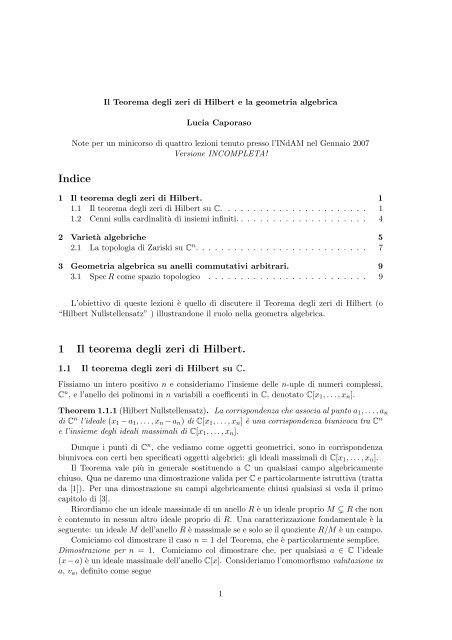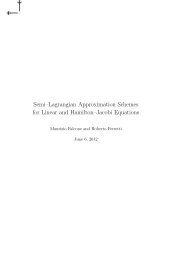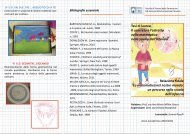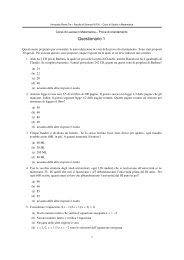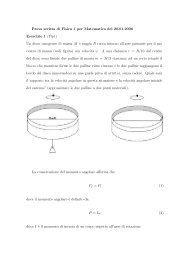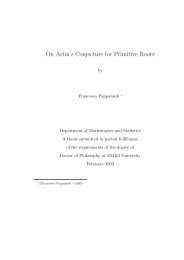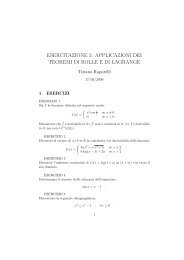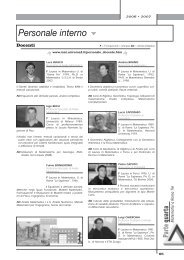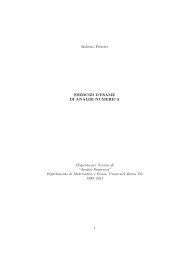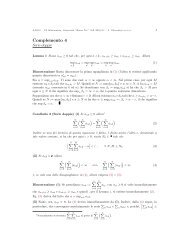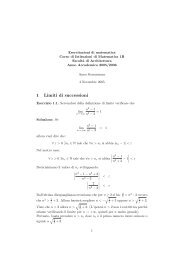Il Teorema degli zeri di Hilbert e la geometria algebrica
Il Teorema degli zeri di Hilbert e la geometria algebrica
Il Teorema degli zeri di Hilbert e la geometria algebrica
- No tags were found...
Create successful ePaper yourself
Turn your PDF publications into a flip-book with our unique Google optimized e-Paper software.
Sia V ⊂ C n una varietà <strong>algebrica</strong> e definiamoI(V ) := {f ∈ C[x 1 , . . . , x n ] : f(a) = 0 ∀a ∈ V } (4)Allora, come conseguenza del <strong>Teorema</strong> <strong>degli</strong> <strong>zeri</strong> <strong>di</strong> <strong>Hilbert</strong> si <strong>di</strong>mostra il seguente<strong>Teorema</strong>, che è in realtà <strong>la</strong> forma originale <strong>Teorema</strong> <strong>degli</strong> <strong>zeri</strong> <strong>di</strong> <strong>Hilbert</strong>.Theorem 2.0.13. Sia I ⊂ C[x 1 , . . . , x n ] un ideale. AlloraI(Z(I)) = √ IOsservazione 2.0.14. In partico<strong>la</strong>re se I è un ideale ra<strong>di</strong>cale, I(Z(I)) = I. Abbiamoquin<strong>di</strong> una corrispondenza biunivoca tra varietà <strong>di</strong> C n e ideali ra<strong>di</strong>cali <strong>di</strong> C[x 1 , . . . , x n ].Dimostrazione. L’inclusione √ I ⊂ I(Z(I)) è facile: sia f ∈ √ I, ovvero f d ∈ I per qualcheintero d. Quin<strong>di</strong> per ogni a ∈ Z(I) abbiamo che f d (a) = 0. Abbiamo 0 = f d (a) = f(a) d ,il che implica che f(a) = 0 e quin<strong>di</strong> f ∈ I(Z(I)).Scegliamo ora per I un sistema finito <strong>di</strong> generatori: I = (f 1 . . . , f r ). Mostrare l’inclusioneopposta significa mostrare che se g ∈ C[x 1 , . . . , x n ] si annul<strong>la</strong> in ogni zero comune<strong>di</strong> f 1 , . . . , f r , allora esiste un intero d tale che g d ∈ I. Nell’anello <strong>di</strong> polinomi in r + 1variabili C[x 1 , . . . , x n , y] consideriamo il polinomio g(x)y − 1; questi ovviamente non siannul<strong>la</strong> <strong>la</strong>ddove g si annul<strong>la</strong>. Da ciò segue che i polinomi f 1 , . . . , f r , g(x)y − 1 non ammettono<strong>zeri</strong> comuni (in C r+1 ). Per 2.0.10 questo equivale a <strong>di</strong>re che esistono polinomih 1 (x, y), . . . , h r+1 (x, y) in C[x 1 , . . . , x n , y] tali che vale l’identità1 =r∑h 1 (x, y)f(x) + h r+1 (x, y)(g(x)y − 1)i=1Sostituendo in essa <strong>la</strong> funzione razionale g(x) −1 al posto <strong>di</strong> y otteniamo1 =r∑ 1h 1 (x,g(x) )f(x).i=1Questa è un’identità <strong>di</strong> funzioni razionali nelle x 1 , . . . , x n , con un (possibile) denominatorecomune <strong>di</strong> tipo g d . Moltiplicando entrambi i <strong>la</strong>ti per tale g d si ottiene g d = ∑ r1 p if i conp i ∈ C[x 1 , . . . , x n ] e quin<strong>di</strong> <strong>la</strong> tesi.2.1 La topologia <strong>di</strong> Zariski su C n .La topologia <strong>di</strong> Zariski su C n è definita dall’avere come c<strong>la</strong>sse <strong>di</strong> insiemi chiusi <strong>la</strong> c<strong>la</strong>sse C<strong>di</strong> tutte le varietà in C n , ovveroC := {Z(T ), ∀T ⊂ C[x 1 , . . . , x n ]}Ricor<strong>di</strong>amo che per definire una topologia <strong>la</strong> c<strong>la</strong>sse C deve(1) contenere ∅ e C n ,(2) contenere l’unione <strong>di</strong> due suoi elementi qualsiasi;(3) contenere l’intersezione <strong>di</strong> una qualsiasi collezione <strong>di</strong> suoi elementi.Dimostriamo che valgono queste tre proprietà : Poiché Z(0) = C n e Z(1) = ∅ <strong>la</strong> (1) vale.7
La (2) segue dal fatto che Z(T 1 ) ∪ Z(T 2 ) = Z(T 1 · T 2 ) per ogni coppia <strong>di</strong> sottoinsiemiT 1 , T 2 <strong>di</strong> C[x 1 , . . . , x n ] (dove T 1 · T 2 := {t 1 t 2 , ∀t i ∈ T i }).Infatti, sia a ∈ Z(T 1 ), allora f(a) = 0 per ogni f ∈ T 1 , quin<strong>di</strong> per ogni g ∈ T 2 abbiamofg(a) = f(a)g(a) = 0 e quin<strong>di</strong> a ∈ Z(T 1 · T 2 ). Dunque Z(T 1 ) ⊂ Z(T 1 · T 2 ); analogamentesi mostra che Z(T 2 ) ⊂ Z(T 1 · T 2 ) e quin<strong>di</strong> Z(T 1 ) ∪ Z(T 2 ) ⊂ Z(T 1 · T 2 ).Per l’inclusione opposta, sia a ∈ Z(T 1 · T 2 ); se a ∈ Z(T 1 ) abbiamo finito. Altrimentiesiste f ∈ T 1 tale che f(a) ≠ 0. Allora per ogni g ∈ T 2 , poiché 0 = (fg)(a) = f(a)g(a),otteniamo g(a) = 0 e quin<strong>di</strong> a ∈ Z(T 2 ).La (3) segue osservando che, se J è una qualsiasi collezione <strong>di</strong> in<strong>di</strong>ci, allora per ogniT j ⊂ C[x 1 , . . . , x n ] abbiamo ∩ j∈J Z(T j ) = Z(∪ j∈J T j ). Quest’ultima verifica è banale.Esercizio 2.1.1. Si <strong>di</strong>mostri che <strong>la</strong> topologia <strong>di</strong> Zariski su C non è <strong>di</strong> Hausdorff, <strong>di</strong>mostrandoche ogni aperto non vuoto <strong>di</strong> C è denso in C.La topologia <strong>di</strong> Zariski induce una topologia sulle varietà algebriche <strong>di</strong> C n per restrizione.Ovvero, data V ⊂ C n , i chiusi <strong>di</strong> V sono tutti e soli quelli ottenuti intersecando Vcon i chiusi (cioè le varietà ) <strong>di</strong> C n .Da ora in poi quin<strong>di</strong> le nostre varietà saranno dotate <strong>di</strong> una struttura topologica.Possiamo quin<strong>di</strong> considerare il concetto <strong>di</strong> funzioni e applicazioni continue. <strong>Il</strong> terminefunzione è <strong>di</strong> norma usato per denotare un’applicazione a valori nel campo <strong>di</strong> numeri <strong>di</strong>“base (il campo C nel nostro caso).Sulle nostre varietà possiamo considerare le funzioni determinate da polinomi.Consideriamo il caso <strong>di</strong> C n ; sia p ∈ C[x 1 , . . . , x n ], allora p definisce <strong>la</strong> funzione seguenteC n −→ Ca ↦→ p(a)è ovvio che due polinomi <strong>di</strong>versi definiscono funzioni <strong>di</strong>verse. Dunque C[x 1 , . . . , x n ] puòesser visto come un insieme <strong>di</strong> partico<strong>la</strong>ri funzioni su C n , dette funzioni rego<strong>la</strong>ri.Sia ora V ⊂ C n una varietà; un polinomio p definisce anche una funzione su V . Duepolinomi p e p ′ definiscono su V <strong>la</strong> stessa funzione se e solo se per ogni a ∈ V risultap(a) = p ′ (a), ovvero se e solo se p − p ′ ∈ I(V ). Sia I = I(V ); da quanto detto segueche l’anello quoziente C[x 1 , . . . , x n ]/I definisce un insieme <strong>di</strong> funzioni su V , dette funzionirego<strong>la</strong>ri. Dunque l’anello quoziente C[x 1 , . . . , x n ]/I ha una sua interpretazione geometrica;introduciamo <strong>la</strong> notazioneC[V ] := C[x 1, . . . , x n ].I(V )Per caratterizzare gli anelli <strong>di</strong> tipo C[V ] premettiamoOsservazione 2.1.2. Sia I ⊂ C[x 1 , . . . , x n ] un ideale. Allora I è un ideale ra<strong>di</strong>cale se esolo se C[x 1 , . . . , x n ]/I è un anello ridotto, ovvero, un anello privo <strong>di</strong> elementi nilpotenti. La<strong>di</strong>mostrazione è <strong>la</strong>sciata per esercizio (ricor<strong>di</strong>amo che un elemento nilpotente è un elementonon nullo f tale che esiste d ∈ N per cui f d = 0.Dunque <strong>la</strong> corrispondenza biunivoca descritta in 2.0.14 tra varietà in C n e ideali ra<strong>di</strong>caliin C[x 1 , . . . , x n ] induce una corrispondenza biunivoca tra l’insieme <strong>di</strong> tutte le varietà in C n el’insieme <strong>di</strong> tutti i quozienti <strong>di</strong> C[x 1 , . . . , x n ] che siano privi <strong>di</strong> nilpotenti. Più precisamente,tale corrispondenza è infatti un’equivalenza <strong>di</strong> categorie che inverte i morfismi. Questosignifica che ad ogni omomorfismo λ : C[V ] −→ C[V ′ ] corrisponde un unico morfismo <strong>di</strong>varietà Φ : V ′ −→ V tale che λ coincide con il pull-back <strong>di</strong> funzione tramite Φ.8(5)
3 Geometria <strong>algebrica</strong> su anelli commutativi arbitrari.Sia adesso R un anello commutativo qualsiasi, tale che 1 ∈ R. Vogliamo associare ad Run oggetto geometrico, estendendo quanto fatto nel caso in cui R è un anello <strong>di</strong> polinomia coefficienti in C o, più in generale, una C-algebra finitamente generata. Chiameremoschema tale oggetto geometrico<strong>Il</strong> primo passo è quello <strong>di</strong> associare a R uno spazio, che costituisca l’insieme <strong>di</strong> puntisoggiacente allo “schema che vogliamo definire. Sul modello <strong>di</strong> quanto stu<strong>di</strong>ato, ispiratidal teorema <strong>degli</strong> <strong>zeri</strong> <strong>di</strong> <strong>Hilbert</strong>, un can<strong>di</strong>dato naturale per tale spazio è l’insieme <strong>di</strong> tuttigli ideali massimali <strong>di</strong> R. Denotiamo Max(R) l’insieme <strong>di</strong> tutti gli ideali massimali <strong>di</strong> R.L’obiettivo finale è quello <strong>di</strong> ottenere una equivalenza <strong>di</strong> categorie tra <strong>la</strong> categoria <strong>degli</strong>anelli commutativi unitari, con gli omomorfismi <strong>di</strong> anelli, e <strong>la</strong> categoria <strong>di</strong> questi schemi(da definire) con i loro morfismi (anch’essi da definire).Tale equivalenza, come nel caso delle varietà , deve invertire le frecce, ovvero ad unomomorfismo λ : R −→ R ′ deve corrispondere un morfismo <strong>di</strong> schemi che vada dalloschema associato ad R ′ a quello associato ad R.Se i nostri schemi fossero supportati sull’insieme <strong>degli</strong> ideali massimali, dovremmo avereun morfismo φ : Max(R ′ ) −→ Max(R) associato a λ in modo funtoriale. In partico<strong>la</strong>redovremmo avere che φ(M ′ ) = λ −1 (M ′ ). C’è però un problema: se M ⊂ R ′ è un idealemassimale in R ′ , l’ideale λ −1 (M ′ ) non è necessariamente un ideale massimale <strong>di</strong> R.Per esempio, nell’inclusione λ : Z ↩→ Q[x] <strong>la</strong> preimmagine dell’ideale massimale (x) èl’ideale 0 in Z che certo non è massimale.Questo ci <strong>di</strong>ce che Max(R) non è lo spazio giusto. Osserviamo ora che per ogni omomorfismoλ : R −→ R ′ , <strong>la</strong> preimmagine <strong>di</strong> un ideale primo <strong>di</strong> R ′ è un ideale primo <strong>di</strong>R. <strong>Il</strong> modo giusto <strong>di</strong> procedere è infatti proprio quello <strong>di</strong> considerare non solo gli idealimassimali (che ovviamente sono anche primi) ma tutti gli ideali primi <strong>di</strong> R. DefiniamoSpec R := {P R : P è un ideale primo }.(Ricor<strong>di</strong>amo che un ideale primo <strong>di</strong> un anello R è un ideale proprio P ⊂ R tale che l’anelloquoziente R/P è privo <strong>di</strong> <strong>di</strong>visori dello 0).Consideriamo questa definizione nel caso R = C[x], e confrontiamo<strong>la</strong> con C, <strong>la</strong> varietàassociata ad R precedentemente. Notiamo che, come insiemi <strong>di</strong> punti, Spec C[x] contieneesattamente un punto in più rispetto a C. Sia infatti P ⊂ C[x] un ideale primo, allora cisono due possibilità , o P è l’ideale (0) oppure P è un ideale massimale. Sappiamo che gliideali massimali <strong>di</strong> C[x] sono in corrispondenza biunivoca con i punti <strong>di</strong> C; conclu<strong>di</strong>amoquin<strong>di</strong> che, come insieme, Spec C[x] è come C con l’aggiunta del punto (0). Vedremo trapoco che questo comporta un’importante <strong>di</strong>fferenza geometrica (anzi, topologica).3.1 Spec R come spazio topologicoProcedendo in modo analogo a quanto fatto per le varietà , definiremo ora su Spec R unastruttura <strong>di</strong> spazio topologico, basata sul<strong>la</strong> definizione seguente: sia T ⊂ R,V (T ) := {P ∈ Spec R : T ⊂ P } ⊂ Spec ROvvero: V (T ) è il luogo <strong>di</strong> tutti gli ideali primi contenenti T . Definiamo ora su Spec R <strong>la</strong>topologia <strong>di</strong> Zariski, che ha come c<strong>la</strong>sse <strong>di</strong> insiemi chiusi <strong>la</strong> c<strong>la</strong>sse C definita qua sotto in9
due mo<strong>di</strong> equivalentiC = {V (T ), ∀T ⊂ R} = {V (I), ∀I ideale <strong>di</strong> R}. (6)Va verificato che <strong>la</strong> c<strong>la</strong>sse C definisce una topologia, e che le due definizioni sono equivalenti.Questa seconda verifica è banale e <strong>la</strong>sciata per esercizio. Dimostriamo invece che (1) Ccontiene l’insieme vuoto e tutto Spec R, e che C è chiusa (2) rispetto all’unione finita e (3)rispetto all’intersezione qualsiasi.Per (1), osserviamo che ∅ = V (1) e Spec R = V (0).Per (2) abbiamo che V (I 1 ) ∪ V (I 2 ) = V (I 1 · I 2 ).Infatti, l’inclusione V (I 1 ) ∪ V (I 2 ) ⊂ V (I 1 · I 2 ) è ovvia, poichè I j ⊃ I 1 · I 2 .Viceversa, se P ∈ V (I 1 · I 2 ) e, <strong>di</strong>ciamo, P non contiene I 1 , allora esiste f ∈ I 1 noncontenuto in P . Poiché P ⊃ I 1·I 2 , per ogni g ∈ I 2 abbiamo che fg ∈ P e quin<strong>di</strong>, poiché P èprimo e non contiene f, ogni elemento g <strong>di</strong> I 2 sta in P . Quin<strong>di</strong> P ∈ V (I 2 ) ⊂ V (I 1 )∪V (I 2 ).Per (3) si mostra facilmente che ∩ i V (T i ) = V (∪ i T i ) per i in qualsiasi insieme <strong>di</strong> in<strong>di</strong>ci.Riferimenti bibliografici[1] Michael Artin Algebra. Prentice Hall, Inc., Englewood Cliffs, NJ, 1991[2] M.F.Atiyah, I.G. Macdonald Introduzione all’algebra commutativa Feltrinelli[3] D. Mumford The red book of Varieties and Schemes Springer LNM 135810


